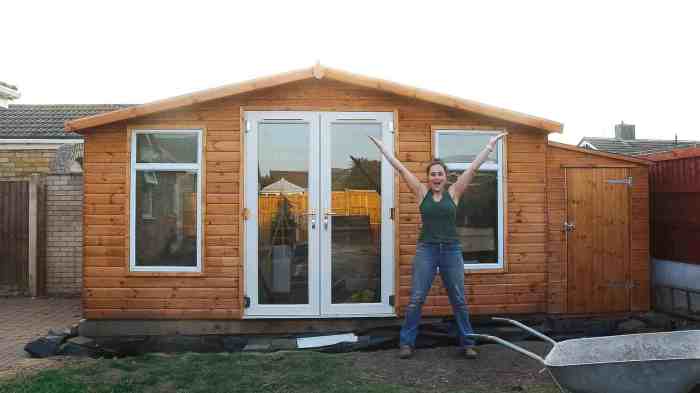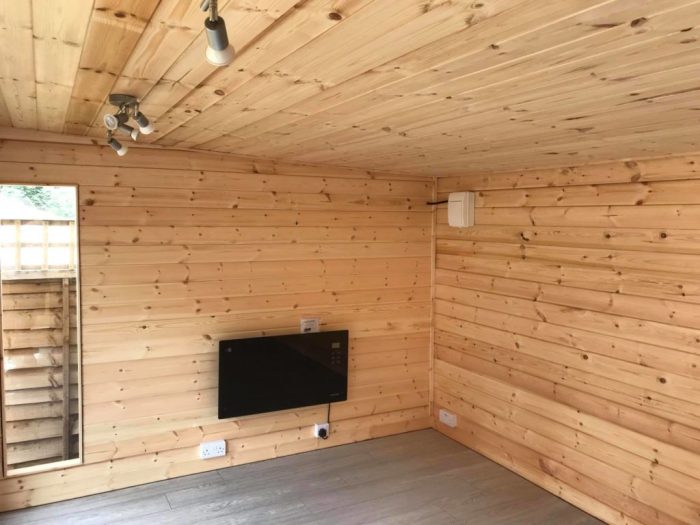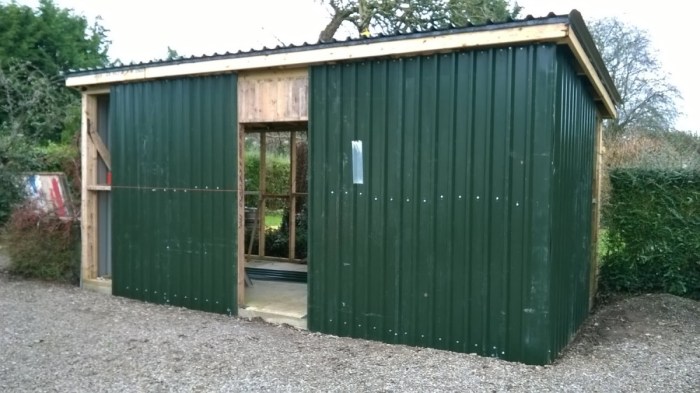Shed cladding ideas are taking center stage, offering a creative canvas to transform your humble shed into a style icon. From traditional wood to modern metal, the cladding options are endless, empowering you to customize your shed’s appearance and functionality.
Dive into this guide to discover the secrets of cladding your shed, ensuring it becomes the envy of your backyard.
Materials for Shed Cladding
Choosing the right cladding material for your shed is essential for durability, aesthetics, and functionality. Here’s an overview of popular options:
Wood
Wood cladding offers a classic and natural look, but requires regular maintenance to prevent rot and decay. Cedar and redwood are popular choices due to their natural resistance to insects and moisture.
Vinyl
Vinyl cladding is a low-maintenance option that comes in a wide range of colors and styles. It’s resistant to fading, moisture, and insects, making it a durable choice for harsh climates.
Metal
Metal cladding, such as aluminum or steel, is highly durable and fire-resistant. It’s often used for industrial or modern-style sheds. However, it can be more expensive and prone to dents.
Composite
Composite cladding is a combination of wood fibers and plastic resins, offering the look of wood with the durability of plastic. It’s low-maintenance, resistant to moisture, and comes in various colors and textures.
Design Considerations for Shed Cladding
When designing shed cladding, several factors should be considered to ensure it meets aesthetic, functional, and practical requirements. These include:
Aesthetics:The cladding should complement the overall design of the shed and enhance its visual appeal. Consider the color, texture, and pattern of the cladding material to create a harmonious or contrasting effect.
Durability and Maintenance, Shed cladding ideas
- Durability:The cladding should be able to withstand the elements and protect the shed from moisture, rot, and pests. Choose materials that are weather-resistant, durable, and require minimal maintenance.
- Maintenance:Consider the maintenance requirements of the cladding material. Some materials, such as vinyl or aluminum, are low-maintenance and easy to clean, while others, like wood, may require regular painting or sealing.
Insulation and Climate
Insulation:If the shed will be used for storage or as a workspace, consider the insulation properties of the cladding material. Insulated cladding can help regulate temperature, reduce condensation, and improve energy efficiency.
Climate:The climate and location of the shed should be considered when selecting cladding materials. In areas with extreme temperatures or heavy rainfall, materials that are resistant to warping, cracking, or fading are recommended.
Installation Techniques for Shed Cladding
Installing shed cladding is a relatively simple task that can be completed in a few hours. However, it is important to follow the proper steps to ensure that the cladding is installed correctly and will last for many years.
Step-by-Step Instructions
- Prepare the shed.The first step is to prepare the shed for cladding. This involves removing any old cladding, repairing any damaged areas, and making sure that the shed is level and square.
- Install the starter strip.The starter strip is a piece of cladding that is installed at the bottom of the shed. It provides a level surface for the rest of the cladding to be installed on.
- Install the cladding.The cladding is installed by overlapping the pieces and fastening them to the shed with nails or screws. It is important to make sure that the cladding is installed tightly and that there are no gaps between the pieces.
- Seal the cladding.Once the cladding is installed, it is important to seal it to protect it from the elements. This can be done with a clear sealant or a paint.
Tips
* Use a level to make sure that the cladding is installed straight.
- Overlap the pieces of cladding by at least 1 inch.
- Fasten the cladding with nails or screws that are at least 2 inches long.
- Seal the cladding with a clear sealant or a paint.
Aesthetic Options for Shed Cladding

The visual appeal of your shed can be greatly enhanced by selecting the appropriate cladding. Explore various design styles and patterns to complement the overall aesthetic of your property.
From traditional to modern, rustic to coastal, each style offers unique characteristics that can elevate the appearance of your shed. Consider the use of colors, textures, and finishes to further customize the look and create a cohesive outdoor space.
Traditional
- Timeless designs with classic lines and shapes
- Neutral colors like white, gray, or beige
- Materials such as wood, vinyl, or metal
Modern
- Sleek and contemporary designs with clean lines
- Bold colors and geometric patterns
- Materials such as metal, glass, or composite
Rustic
- Natural and weathered look with rough-hewn textures
- Earthy tones like brown, green, or gray
- Materials such as wood, stone, or brick
Coastal
- Light and airy designs inspired by seaside living
- Pastel colors like blue, green, or white
- Materials such as wood, vinyl, or fiber cement
Energy-Efficient Cladding for Sheds

Energy-efficient cladding materials can significantly reduce heat loss and improve the thermal performance of your shed, resulting in lower energy bills and a more comfortable interior.
Insulated Panels
Insulated panels consist of a rigid foam core sandwiched between two metal or plastic sheets. The foam core provides excellent insulation, preventing heat from escaping during winter and entering during summer.
Reflective Coatings
Reflective coatings are applied to the exterior of cladding materials to reflect sunlight and reduce heat absorption. This helps keep the shed cooler in hot climates, reducing the need for air conditioning.
Examples of Energy-Efficient Cladding Systems
* Metal panels with insulated foam cores
- Vinyl siding with reflective coatings
- Composite panels with a UV-resistant finish
Low-Maintenance Cladding for Sheds

Choosing low-maintenance cladding materials for your shed can save you time, effort, and money in the long run. Vinyl, composite, and metal are all excellent options that require minimal cleaning, painting, or repairs.
Advantages of Low-Maintenance Cladding
- Durability:Low-maintenance cladding materials are designed to withstand harsh weather conditions, including UV rays, moisture, and pests.
- Easy to clean:Most low-maintenance cladding materials can be cleaned with just soap and water, making it easy to keep your shed looking its best.
- Cost-effective:While the initial cost of low-maintenance cladding may be higher than other options, it can save you money in the long run by reducing maintenance costs.
Tips for Selecting Low-Maintenance Cladding
- Consider the climate:Choose a cladding material that is suitable for the climate in your area.
- Look for fade resistance:If your shed will be exposed to direct sunlight, choose a cladding material that is fade-resistant.
- Choose a material that is easy to install:Some cladding materials are easier to install than others. If you are not experienced in DIY projects, choose a material that is easy to work with.
Sustainable Cladding Options for Sheds
Eco-conscious homeowners can explore sustainable cladding options that align with their environmental values. Reclaimed wood, bamboo, and recycled plastic offer eco-friendly alternatives to traditional materials.
Reclaimed Wood
Reclaimed wood, sourced from old structures or discarded lumber, carries the charm of history and reduces waste. Its rustic appearance adds character to sheds while promoting sustainable practices.
Bamboo
Bamboo is a rapidly renewable resource that offers durability and strength. Its natural resistance to moisture and insects makes it an excellent choice for outdoor cladding, minimizing the need for chemical treatments.
Recycled Plastic
Recycled plastic cladding is made from post-consumer or industrial waste, reducing landfill contributions. It is durable, weather-resistant, and low-maintenance, making it a practical and environmentally friendly option.
Cost Considerations for Shed Cladding
Understanding the financial implications of shed cladding is crucial. The overall cost can vary based on the materials, labor, and maintenance requirements.
The cost of materials is a significant factor. Different cladding options have varying prices, with some being more budget-friendly than others.
Material Costs
- Wood: Generally affordable, but requires regular maintenance.
- Vinyl: Mid-range option, offers durability and low maintenance.
- Metal: More expensive, but provides exceptional longevity and energy efficiency.
Labor costs also play a role. The complexity of the cladding installation can affect the amount of time and effort required, thus influencing the overall labor expenses.
Labor Costs
- DIY Installation: Can save on labor costs, but requires skill and experience.
- Professional Installation: Ensures proper installation, but comes with higher labor expenses.
Finally, maintenance costs should be considered. Some cladding materials require more frequent maintenance than others, which can add to the long-term expenses.
Maintenance Costs
- Wood: Requires regular staining or painting to protect against moisture and rot.
- Vinyl: Minimal maintenance, occasional cleaning is sufficient.
- Metal: Highly durable, rarely requires maintenance or repairs.
By carefully considering these factors, you can make an informed decision that balances cost, durability, and maintenance requirements.
Creative Cladding Ideas for Sheds
Sheds can be transformed into captivating structures with creative cladding designs. Reclaimed materials, such as weathered wood or corrugated metal, add a rustic charm. Geometric patterns, like overlapping planks or diamond-shaped tiles, create a striking visual impact. Incorporating natural elements, such as stone or bamboo, brings a touch of the outdoors to your shed.
Examples of Creative Cladding Solutions
- A shed clad in reclaimed barn wood with intricate carvings, giving it an antique aesthetic.
- A modern shed featuring geometric cladding made of interlocking metal panels, creating a dynamic play of light and shadow.
- A garden shed adorned with bamboo cladding, blending seamlessly with its natural surroundings.
Final Review: Shed Cladding Ideas
Whether you seek durability, energy efficiency, or a touch of whimsy, the world of shed cladding ideas has something for everyone. Embrace your creativity and let your shed stand out as a testament to your unique style and practical ingenuity.
Common Queries
What are the most durable cladding materials for sheds?
Metal and composite cladding offer exceptional durability, withstanding harsh weather conditions and requiring minimal maintenance.
How can I improve the energy efficiency of my shed?
Opt for insulated cladding panels or reflective coatings to reduce heat loss and enhance the thermal performance of your shed.
What are some creative cladding ideas for sheds?
Reclaimed wood, geometric patterns, and natural elements can add a unique touch to your shed, transforming it into a work of art.


